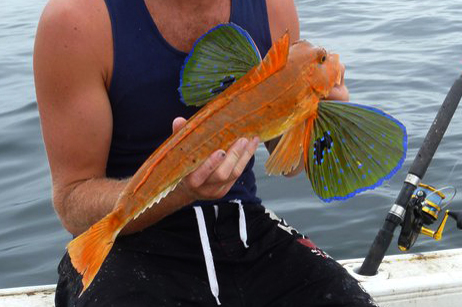Red Gurnard, Chelidonichthys kumu (Cuvier 1829)
Other Names: Bluefin Gurnard, Flying Fish, Flying Gurnard, Gurnard, Kumu Gurnard, Kumukumu (NZ), Latchet

A Red Gurnard, Chelidonichthys kumu, caught at Browns Mountain, off Sydney (New South Wales). Source: Brenden Kong. License: All rights reserved
Summary:
A large reddish to reddish-brown gurnard becoming silvery-white below, with a mostly smooth snout and a row of prominent bony scales along the dorsal fin bases. The inner surface of the pectoral fin is olive-green to greyish or purplish with scattered blue spots, a blue margin, and a large black blotch sometimes with white to bluish speckles near the fin base.
Video of a Red Gurnard at a baited underwater camera off New South Wales, depth 50 m.
Video of a Red Gurnard at a baited underwater camera off New South Wales, depth 50 m.
Cite this page as:
Bray, D.J. 2023, Chelidonichthys kumu in Fishes of Australia, accessed 27 Jun 2025, https://fishesofaustralia.net.au/home/species/3752
Red Gurnard, Chelidonichthys kumu (Cuvier 1829)
More Info
|
Distribution |
Widespread in eastern and southern Australia from off Brisbane, Queensland, around southern Australia including Tasmania, to Shark Bay, Western Australia; also the Lord Howe Province in the Tasman Sea. Elsewhere the species occurs off southern Africa, New Zealand, Hawaii and possibly Chile. Adults prefer deeper offshore waters, while juveniles inhabit shallow bays, estuaries, and sandy coastal areas. |
|
Features |
Dorsal fin VIII-IX + 15-16; Anal fin 14-15; Caudal fin 11; pectoral fin 11+3; Pelvic fin I, 5; Lateral line scales 62-65. Skull without a groove behind eye; front margin of bony rostrum with a broad medial notch or indentation in front of eyes, rostrum mostly smooth without prominent spines. Scales small, somewhat embedded, in 110-120 diagonal rows above lateral line; scales absent from chest and front part of belly; enlarged thorn-like bucklers present along the bases of both dorsal fins; lateral line splitting into two branches on caudal fin. Caudal-fin margin distinctly concave; Pectoral fins large, fin tip extending well beyond the anal-fin origin; lower pectoral-fin rays thickened and free from membrane. |
|
Fisheries |
Often taken in bottom trawls, and also on hook and line. The firm slightly dry flesh is excellent eating. |
|
Etymology |
The specific name is a Latinization of the vernacular name (koumou) for this species in New Zealand. |
|
Species Citation |
Trigla kumu Cuvier, 1829, Histoire Naturelle des Poissons 4: 50. Type locality: New Zealand. |
|
Author |
Bray, D.J. 2023 |
|
Resources |
Red Gurnard, Chelidonichthys kumu (Cuvier 1829)
References
Coleman, N. & Mobley, M. 1984. Diets of commercially exploited fish from Bass Strait and adjacent Victorian waters, southeastern Australia. Australian Journal of Marine and Freshwater Research 35(5): 549-560. https://doi.org/10.1071/MF9840549
Cuvier, G.L. in Cuvier, G.L. & Valenciennes, A. 1829. Histoire Naturelle des Poissons. Paris : Levrault Vol. 4 518 pp. pls 72-99.
Elder, R.D. 1976. Studies on age and growth, reproduction and population dynamics of red gurnard (Chelidonichthys kumu, Lesson and Garnot) in the Hauraki Gulf. New Zealand Fisheries Research Bulletin 12: 1-77.
Gomon, M.F. 1994. Family Triglidae. pp. 494-505 figs 442-450 in Gomon, M.F., Glover, C.J.M. & Kuiter, R.H. (eds). The Fishes of Australia's South Coast. Adelaide : State Printer 992 pp. 810 figs.
Kuiter, R.H. 1993. Coastal Fishes of South-eastern Australia. Bathurst : Crawford House Press 437 pp.
Yearsley, G.K., Last, P.R. & Ward, R.D. (eds) 1999. Australian Seafood Handbook. Hobart : CSIRO Marine Research 460 pp.






